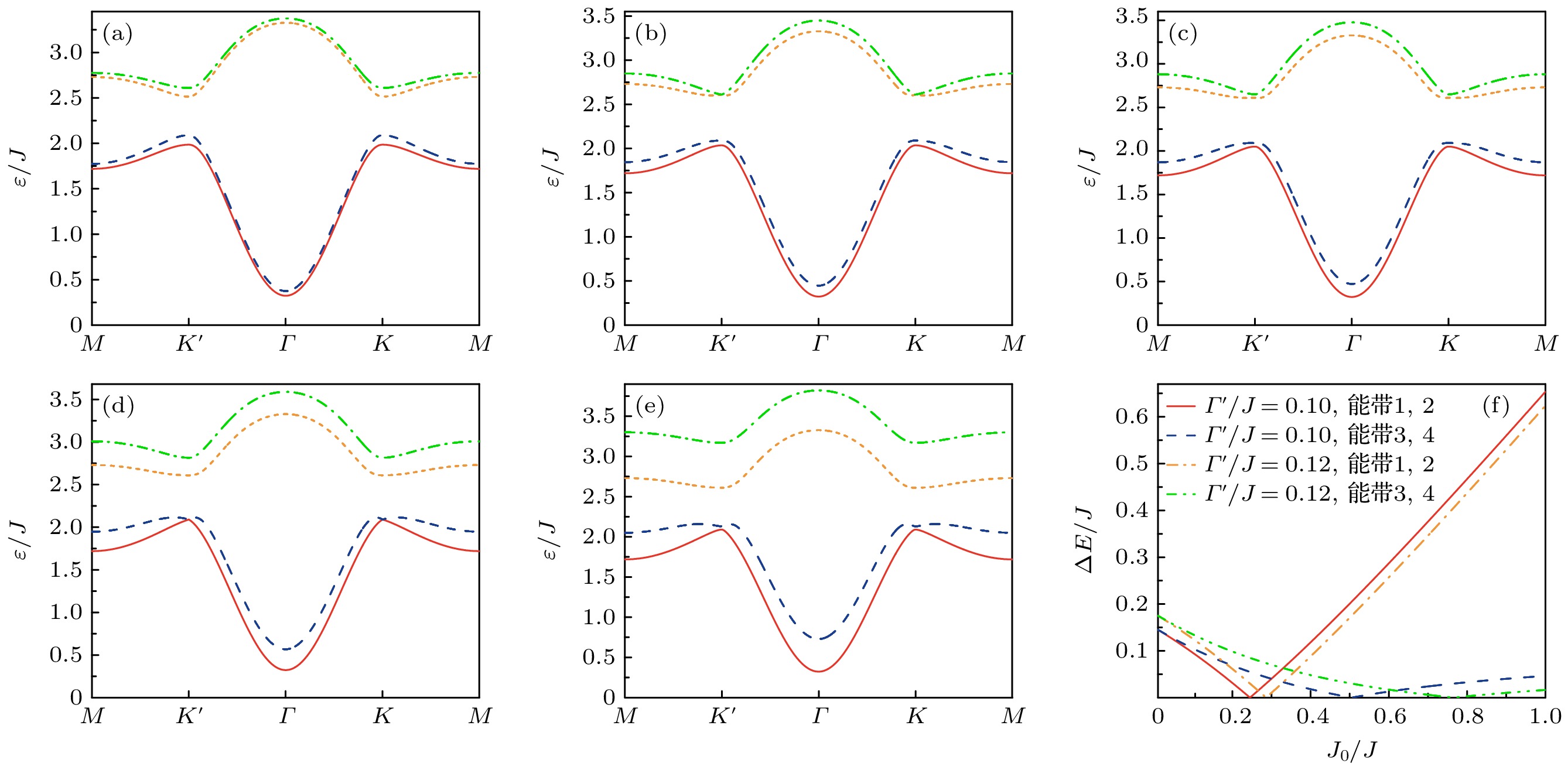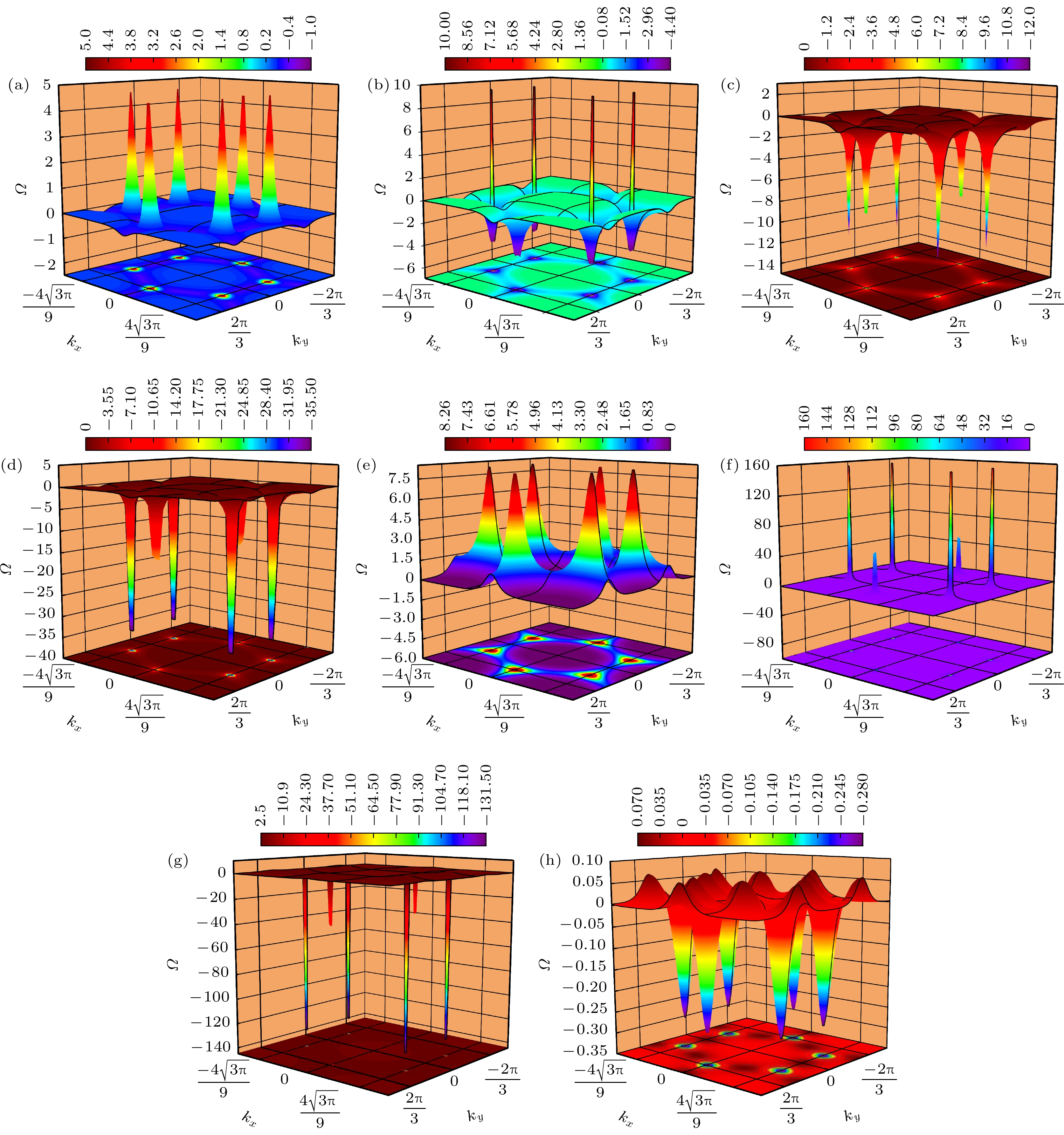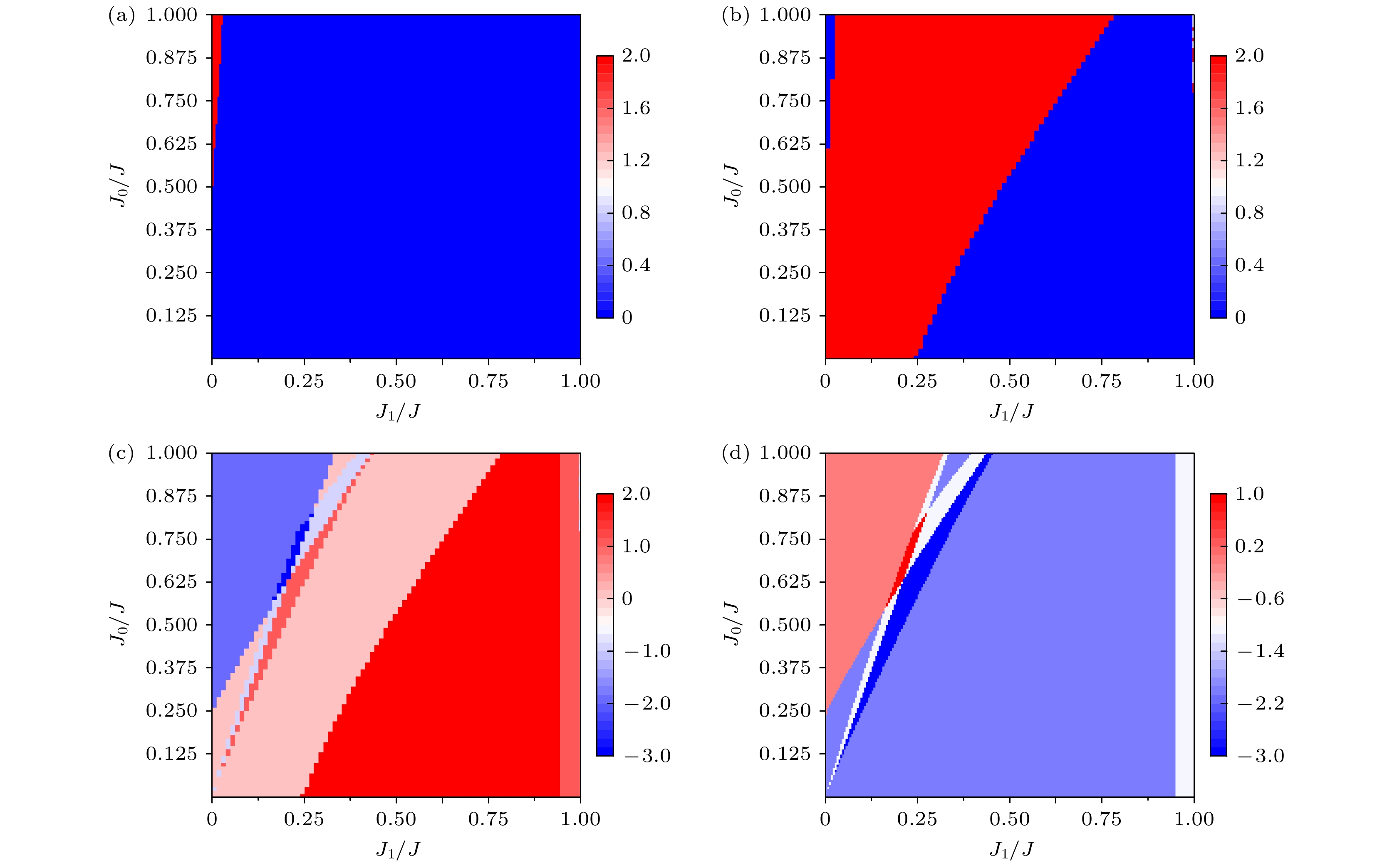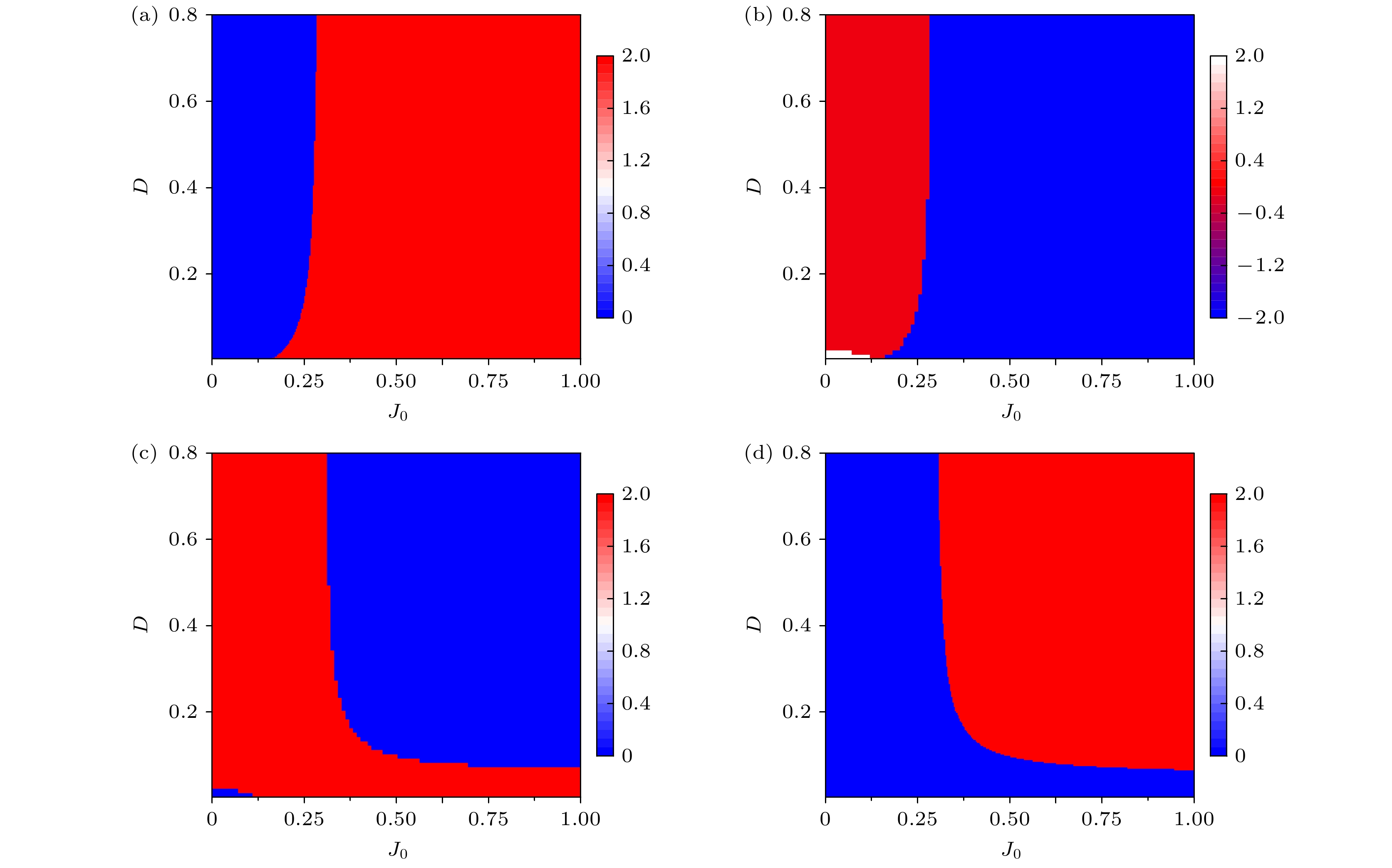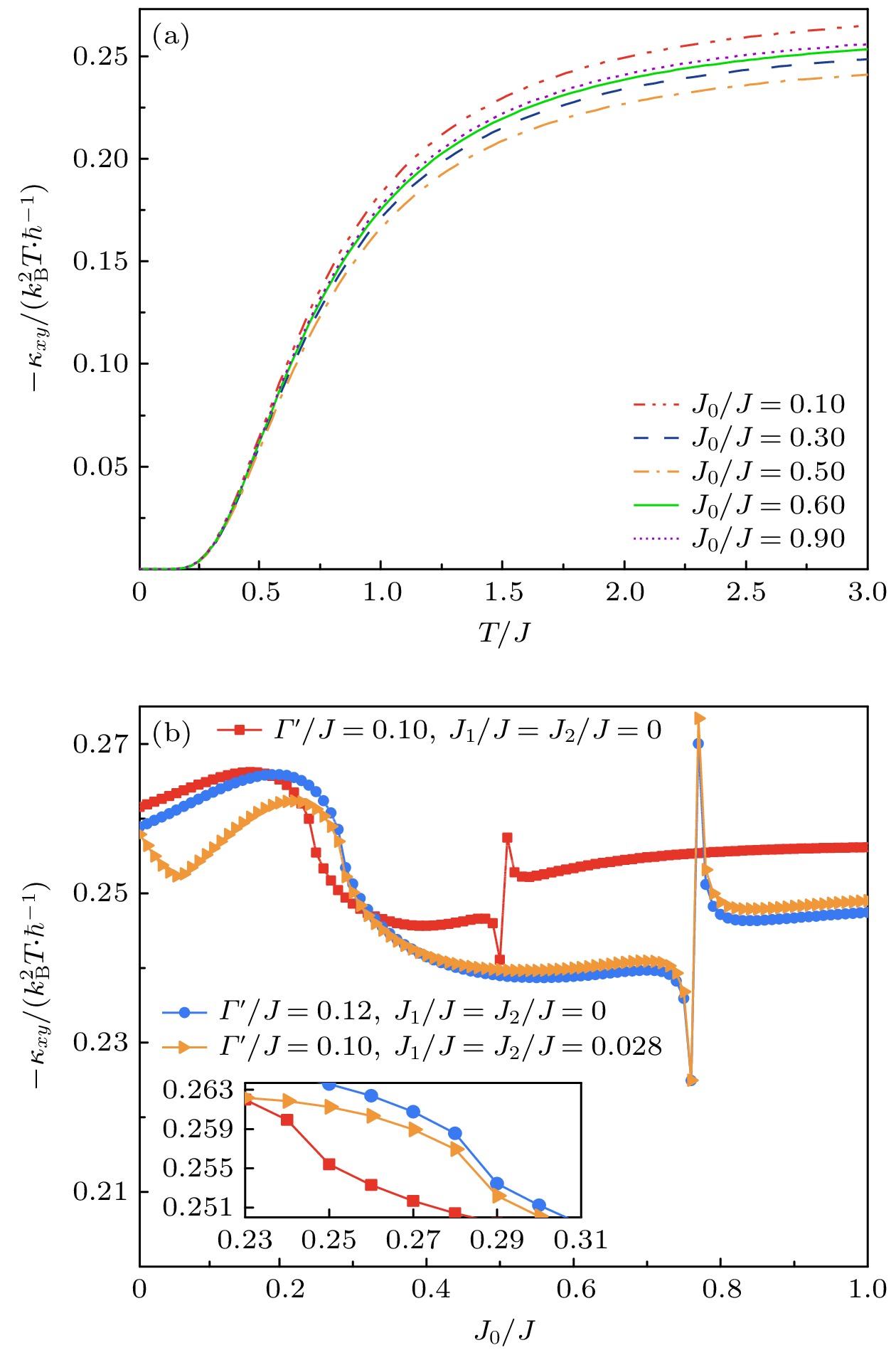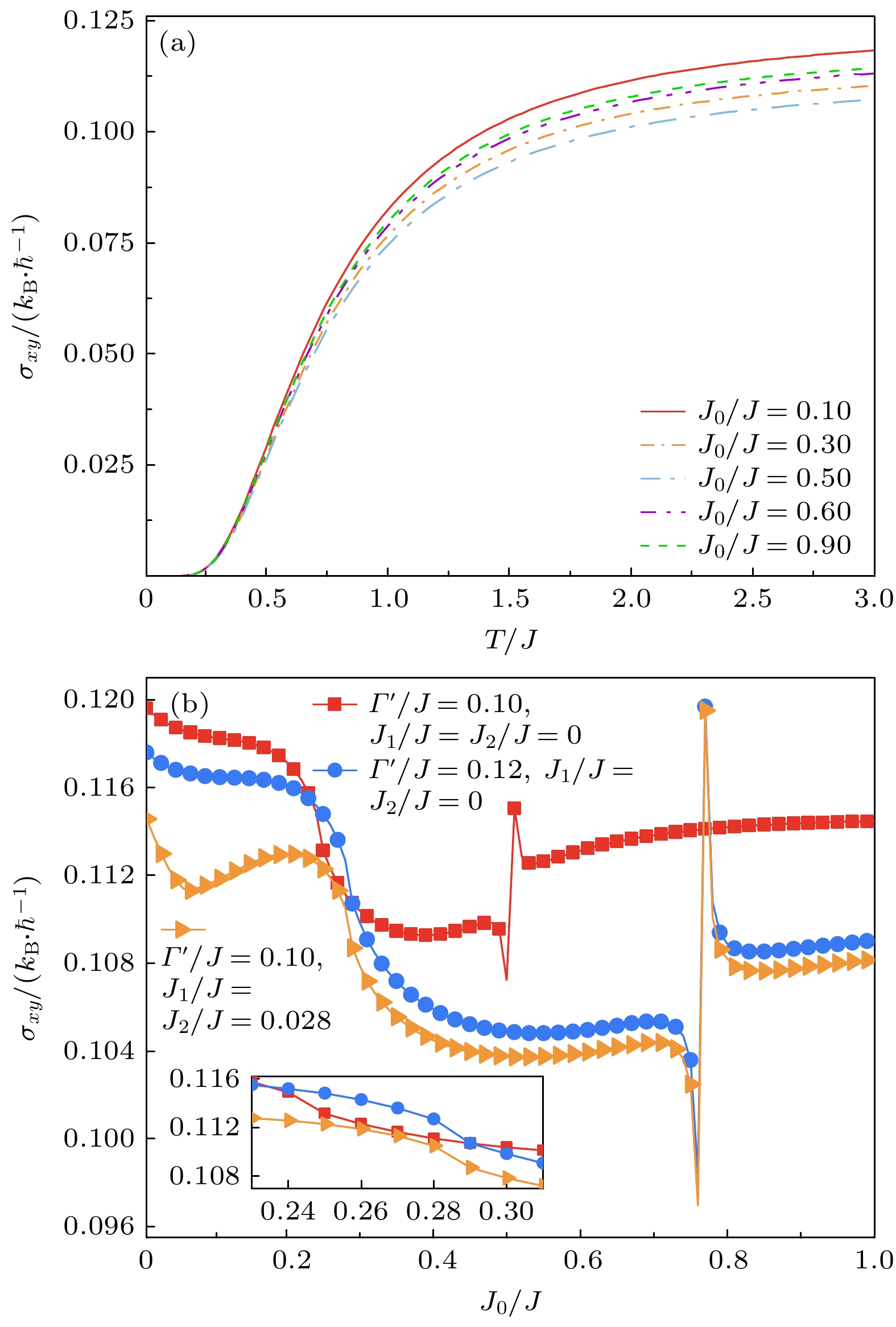-
层状磁性拓扑材料是最小二维单元下同时具有磁序和拓扑性的材料体系, 研究这一体系可能会观察到新物性和新现象的出现, 因此引起了研究者们的广泛关注. 本文运用线性自旋波理论, 主要研究了层间铁磁耦合的双层蜂窝状海森伯铁磁体中层间交换耦合相互作用对系统拓扑相的影响. 通过计算不同层间交换耦合相互作用强度下的磁子色散关系能得出, 当系统达到两个强度临界值时, 能量较高的两条能带和能量较低的两条能带的带隙在狄拉克点处会依次出现闭合-重新打开现象. 计算能带对应的贝里曲率和陈数后, 发现贝里曲率符号在相应临界值前后会发生反转, 同时陈数也会发生改变, 这证明系统发生了拓扑相变. 此外, 本文研究发现当双层蜂窝状铁磁体发生拓扑相变时, 磁子热霍尔系数变化曲线会相应发生突变. 本研究成果可以为利用双层蜂窝状铁磁材料制作具有更高信息传输能力的自旋电子器件提供理论支撑, 也可以为其他双层铁磁系统的相关研究提供一定的理论参考.Layered magnetic topological materials are material systems that exhibit both magnetic ordering and topological properties in their smallest two-dimensional units. Studying these systems may lead to the observation of new physical properties and phenomena, which has attracted considerable attention from researchers. The effect of interlayer exchange coupling interactions on bilayer honeycomb Heisenberg ferromagnets with interlayer coupled topological phase is investigated by using linear spin wave theory. The influence of introducing two additional types of interactions, i.e. interlayer exchange coupling interaction and interlayer easy-axis anisotropy interaction, on the topological phase transition are also explored in this work. By calculating the magnon dispersion relations at various interlayer exchange coupling interaction intensities, it is found that the band gaps of high energy band and low energy band both close and reopen at the Dirac points when the system reaches the critical value of interlayer exchange coupling interaction. In magnon systems, such physical phenomena typically relate to topological phase transitions. When calculating the Berry curvature and Chern numbers for the bands in the aforementioned process, it is found that the sign of the Berry curvature reverses and the Chern numbers change when the critical value of interlayer exchange coupling interaction strength is reached, confirming that a topological phase transition occurs indeed. Introducing two other types of interlayer exchange coupling interactions in this process can lead various novel topological phases to occur in the system. The enhancement of interlayer easy-axis anisotropy interactions is likely to impede the topological phase transitions occurring in the system. We find that a major distinction between bilayer honeycomb ferromagnets and their single-layer counterparts lies in the fact that during a topological phase transition, the sign of the magnon thermal Hall coefficient does not change; on the contrary, abrupt shift in the thermal Hall coefficient curve occurs which can be seen as an indicator of topological phase transition of bilayer honeycomb ferromagnets, and is also reflected in the change in magnon Nernst coefficient. The research results of this work can provide theoretical support for developing novel spintronic devices with enhanced information transmission capabilities by using bilayer honeycomb ferromagnetic materials, and can also provide theoretical reference for studing other bilayer ferromagnetic systems.
-
Keywords:
- bilayer ferromagnet /
- topological physics /
- tnterlayer exchange coupling /
- linear spin wave theory
[1] Zhang S Q, Xu R Z, Luo N N, Zou X L 2021 Nanoscale 13 1398
 Google Scholar
Google Scholar
[2] Liu Z R, Hua C B, Peng T, Chen R, Zhou B 2023 Phys. Rev. B 107 125302
 Google Scholar
Google Scholar
[3] 张志东 2015 物理学报 64 067503
 Google Scholar
Google Scholar
Zhang Z D 2015 Acta Phys. Sin. 64 067503
 Google Scholar
Google Scholar
[4] Xu M L, Huang C X, Li Y W, Liu S Y, Zhong X, Jena P, Kan E J, Wang Y C 2020 Phys. Rev. Lett. 124 067602
 Google Scholar
Google Scholar
[5] MacDonald A H 2019 Physics 12 12
 Google Scholar
Google Scholar
[6] Cao Y, Fatemi V, Fang S, Watanabe K, Taniguchi T, Kaxiras E, Herrero P J 2018 Nature 556 43
 Google Scholar
Google Scholar
[7] Tarnopolsky G, Kruchkov A J, Vishwanath A 2019 Phys. Rev. Lett. 122 106405
 Google Scholar
Google Scholar
[8] Carr S, Fang S, Jarillo-Herrero P, Kaxiras E 2018 Phys. Rev. B 98 085144
 Google Scholar
Google Scholar
[9] Yankowitz M, Chen S, Polshyn H, Zhang Y, Watanabe K, Taniguchi T, Graf D, Young A F, Dean C R 2019 Science 363 1059
 Google Scholar
Google Scholar
[10] Ribeiro-Palau R, Zhang C, Watanabe K, Taniguchi T, Hone J, Dean C R 2018 Science 361 690
 Google Scholar
Google Scholar
[11] Guerci D, Simon P, Mora C 2021 Phys. Rev. B 103 224436
 Google Scholar
Google Scholar
[12] Feng H F, Li Y, Shi Y G, Xie H Y, Li Y Q, Xu Y 2022 Chin. Phys. Lett. 39 077501
 Google Scholar
Google Scholar
[13] Cenker J, Huang B, Suri N, Thijssen P, Miller A, Song T, Taniguchi T, Watanabe K 2021 Nat. Phys. 17 20
 Google Scholar
Google Scholar
[14] Kang S, Kim K, Kim B H, Kim J, Sim K I, Lee J U, Lee S, Park K, Yun S, Kim T, Nag A, Walters A, Garcia-Fernandez M, Li J, Chapon L, Zhou K J, Son Y W, Kim J H, Cheong H, Park J G 2020 Nature 583 785
 Google Scholar
Google Scholar
[15] Zhang H, Feng X, Heitmann T, Kolesnikov A I, Stone M B, Lu Y M 2020 Phys. Rev. B 101 100405
 Google Scholar
Google Scholar
[16] Zhang L C, Zhu F, Go D, Lux F R, dos Santos F J, Lounis S, Su Y, Blügel S, Mokrousov Y 2021 Phys. Rev. B 103 134414
 Google Scholar
Google Scholar
[17] Ghader D, Khater A 2019 Sci. Rep. 9 15220
 Google Scholar
Google Scholar
[18] Van Miert G, Smith C M 2016 Phys. Rev. B 93 035401
 Google Scholar
Google Scholar
[19] Wang X S, Wang X R 2021 J. Appl. Phys. 129 151101
 Google Scholar
Google Scholar
[20] 王振宇, 李志雄, 袁怀洋, 张知之, 曹云姗, 严鹏 2023 物理学报 72 057503
 Google Scholar
Google Scholar
Wang Z Y, Li Z X, Yuan H Y, Zhang Z Z, Cao Y S, Yan P 2023 Acta Phys. Sin. 72 057503
 Google Scholar
Google Scholar
[21] Stauber T, Low T, Gómez-Santos G 2018 Phys. Rev. Lett. 120 046801
 Google Scholar
Google Scholar
[22] Ma J J, Wang Z Y, Xu S G, Gao Y X, Zhang Y Y, Dai Q, Lin X, Du S X, Ren J D, Gao H J 2022 Chin. Phys. Lett. 39 047403
 Google Scholar
Google Scholar
[23] Hu J W, Zhu S Y, Hu Q Y, Wang Y H, Shen C M, Yang H T, Zhu X S, Huan Q, Xu Y, Gao H J 2024 Chin. Phys. Lett. 41 037401
 Google Scholar
Google Scholar
[24] Li X F, Sun R X, Wang S Y, Li X, Liu Z B, Tian J G 2022 Chin. Phys. Lett. 39 037301
 Google Scholar
Google Scholar
[25] Liu C F, Wang J 2022 Chin. Phys. Lett. 39 077301
 Google Scholar
Google Scholar
[26] Lee J Y 2019 Nat. Commun. 10 5333
 Google Scholar
Google Scholar
[27] Zhang Y H, Mao D, Cao Y, Jarillo-Herrero P, Senthil T 2019 Phys. Rev. B 99 075127
 Google Scholar
Google Scholar
[28] Po H C, Zou L, Senthil T, Vishwanath A 2019 Phys. Rev. B 99 195455
 Google Scholar
Google Scholar
[29] Hao Z, Zimmerman A M, Ledwith P, Khalaf E, Najafabadi D H, Watanabe K, Taniguchi T, Ashvin Vishwanath, Kim P 2021 Science 371 1133
 Google Scholar
Google Scholar
[30] Nuckolls K P, Oh M, Wong D, Lian B, Watanabe K, Taniguchi T, Bernevig B A 2020 Nature 588 610
 Google Scholar
Google Scholar
[31] Rademaker L, Mellado P 2018 Phys. Rev. B 98 235158
 Google Scholar
Google Scholar
[32] Moon P, Koshino M 2014 Phys. Rev. B 90 155406
 Google Scholar
Google Scholar
[33] Zhu X C, Guo H M, Feng S P 2021 Chin. Phys. B 30 077505
 Google Scholar
Google Scholar
[34] Ghader D 2020 Sci. Rep. 10 16733
 Google Scholar
Google Scholar
[35] Zyuzin V A, Kovalev A 2016 Phys. Rev. Lett. 117 217203
 Google Scholar
Google Scholar
[36] Huang H, Kariyado T, Hu X 2022 Sci. Rep 12 6257
 Google Scholar
Google Scholar
[37] Zhai X, Blanter Y M 2020 Phys. Rev. B 102 075407
 Google Scholar
Google Scholar
[38] Ghader D 2022 Physica E 135 114984
 Google Scholar
Google Scholar
[39] Kim H, Kim S K 2022 Phys. Rev. B 106 104430
 Google Scholar
Google Scholar
[40] Katsura H, Nagaosa N, Lee P A 2010 Phys. Rev. Lett. 104 066403
 Google Scholar
Google Scholar
[41] Matsumoto R, Murakami S 2011 Phys. Rev. B 84 184406
 Google Scholar
Google Scholar
[42] Owerre S A 2016 J. Appl. Phys. 120 043903
 Google Scholar
Google Scholar
[43] Zhang X T, Gao Y H, Chen G 2024 Phys. Rep. 1070 1
 Google Scholar
Google Scholar
[44] Lu Y S, Li J L, Wu C T 2021 Phys. Rev. Lett. 127 217202
 Google Scholar
Google Scholar
[45] Saito T, Misaki K, Ishizuka H, Nagaosa N 2019 Phys. Rev. Lett. 123 255901
 Google Scholar
Google Scholar
[46] Ideue T, Onose Y, Katsura H, Shiomi Y, Ishiwata S, Nagaosa N, Tokura Y 2012 Phys. Rev. B 85 134411
 Google Scholar
Google Scholar
[47] Xu H, Cheng S F, Bao S, Wen J S 2022 Progress in Physics 42 159
 Google Scholar
Google Scholar
[48] Hirschberger M, Chisnell R, Lee Y S, Ong N P 2015 Phys. Rev. Lett. 115 106603
 Google Scholar
Google Scholar
[49] Chisnell R, Helton J S, Freedman D E, Singh D K, Demmel F, Stock C, Nocera D G, Lee Y S 2016 Phys. Rev. B 93 214403
 Google Scholar
Google Scholar
[50] McClarty P A, Dong X Y, Gohlke M, Rau J G, Pollmann F, Moessner R, Penc K 2018 Phys. Rev. B 98 060404
 Google Scholar
Google Scholar
[51] Rückriegel A, Brataas A, Duine R A 2018 Phys. Rev. B 97 081106
 Google Scholar
Google Scholar
[52] Mkhitaryan V V, Ke L 2021 Phys. Rev. B 104 064435
 Google Scholar
Google Scholar
[53] Wang S Y, Wang Y, Yan S H, Wang C, Xiang B K, Liang K Y, He Q S, Watanabe K, Taniguchi T, Tian S J, Lei H C, Ji W, Qi Y, Wang Y H 2022 Sci. Bull. 67 2557
 Google Scholar
Google Scholar
[54] Diaz S A, Klinovaja J, Loss D 2019 Phys. Rev. Lett. 122 187203
 Google Scholar
Google Scholar
[55] McClarty P A 2022 Annu. Rev. Conde. Ma. P 13 171
 Google Scholar
Google Scholar
[56] Liu J, Wang L, Shen K 2023 Phys. Rev. B 107 174404
 Google Scholar
Google Scholar
[57] Mook A, Plekhanov K, Klinovaja J, Loss D 2021 Phys. Rev. X 11 021061
 Google Scholar
Google Scholar
[58] Pirmoradian F, Rameshti B Z, Miri M F, Saeidian S 2018 Phys. Rev. B 98 224409
 Google Scholar
Google Scholar
[59] Chen L 2019 Chin. Phys. B 28 078503
 Google Scholar
Google Scholar
[60] Zhu H, Shi H C, Tang Z, Tang B 2023 Eur. Phys. J. Plus 138 1
 Google Scholar
Google Scholar
[61] Yao S Y, Wang Z 2018 Phys. Rev. Lett. 121 086803
 Google Scholar
Google Scholar
[62] Corticelli A, Moessner R, McClarty P A 2022 Phys. Rev. B 105 064430
 Google Scholar
Google Scholar
[63] Zhang L, Ren J, Wang J S, Li B 2013 Phys. Rev. B 87 144101
 Google Scholar
Google Scholar
[64] Choe D H, Sung H J, Chang K J 2016 Phys. Rev. B 93 125109
 Google Scholar
Google Scholar
[65] Rufo S, Lopes N, Continentino M A, Griffith M A R 2019 Phys. Rev. B 100 195432
 Google Scholar
Google Scholar
[66] Zhang J S, Chang C Z, Tang P Z, Zhang Z C, Feng X, Li K, Wang L L, Chen X, Liu C X, Duan W H, He K, Xue Q K, Ma X C, Wang Y Y 2013 Science 339 1582
 Google Scholar
Google Scholar
[67] 孟康康, 赵旭鹏, 苗君, 徐晓光, 赵建华, 姜勇 2018 物理学报 67 131202
 Google Scholar
Google Scholar
Meng K K, Zhao X P, Miao J, Xu X G, Zhao J H, Jiang Y 2018 Acta Phys. Sin. 67 131202
 Google Scholar
Google Scholar
[68] Mook A, Henk J, Mertig I 2014 Phys. Rev. B 90 024412
 Google Scholar
Google Scholar
[69] Joshi D G 2018 Phys. Rev. B 98 060405
 Google Scholar
Google Scholar
[70] Asano K, Hotta C 2011 Phys. Rev. B 83 245125
 Google Scholar
Google Scholar
[71] Fransson J, Black-Schaffer A M, Balatsky A V 2016 Phys. Rev. B 94 075401
 Google Scholar
Google Scholar
[72] Pershoguba S S, Banerjee S, Lashley J C, Park J, Agren H, Aeppli G, Balatsky A V 2018 Phys. Rev. X 8 011010
 Google Scholar
Google Scholar
[73] Wang D, Bo X Y, Tang F, Wan X G 2019 Phys. Rev. B 99 035160
 Google Scholar
Google Scholar
[74] Sun H, Bhowmick D, Yang B, Sengupta P 2023 Phys. Rev. B 107 134426
 Google Scholar
Google Scholar
[75] Do S H, Paddison J A M, Sala G, Williams T J, Kaneko K, Kuwahara K, May A F, Yan J, McGuire M A, Stone M B, Lumsden M D, Christianson A D 2022 Phys. Rev. B 106 L060408
 Google Scholar
Google Scholar
[76] 刘畅, 王亚愚 2023 物理学报 72 177301
 Google Scholar
Google Scholar
Liu C, Wang Y Y 2023 Acta Phys. Sin. 72 177301
 Google Scholar
Google Scholar
[77] 孙慧敏, 何庆林 2021 物理学报 70 127302
 Google Scholar
Google Scholar
Sun H M, He Q L 2021 Acta Phys. Sin. 70 127302
 Google Scholar
Google Scholar
[78] Xu C Q, Zhang H D, Carnahan C, Zhang P P, Xiao D, Ke X L 2024 Phys. Rev. B 109 094415
 Google Scholar
Google Scholar
[79] Zhang E Z, Chern L E, Kim Y B 2021 Phys. Rev. B 103 174402
 Google Scholar
Google Scholar
[80] 强晓斌, 卢海舟 2021 物理学报 70 027201
 Google Scholar
Google Scholar
Qiang X B, Lu H Z 2021 Acta Phys. Sin. 70 027201
 Google Scholar
Google Scholar
[81] Kovalev A A, Zyuzin V 2016 Phys. Rev. B 93 161106
 Google Scholar
Google Scholar
[82] Bose A, Tulapurkar A A 2019 J. Magn. Magn. Mater. 491 165526
 Google Scholar
Google Scholar
[83] Go G, Kim S K 2022 Phys. Rev. B 106 125103
 Google Scholar
Google Scholar
[84] Cui Q R, Zeng B W, Cui P, Yu T, Yang H X 2023 Phys. Rev. B 108 L180401
 Google Scholar
Google Scholar
[85] Hu C, Zhang D, Yan F G, Li Y C, Lü Q S, Zhu W K, Wei Z K, Chang K M, Wang K Y 2020 Sci. Bull. 65 1072
 Google Scholar
Google Scholar
[86] Soriano D, Cardoso C, Fernández-Rossier J 2019 Solid State Commun. 299 113662
 Google Scholar
Google Scholar
[87] 金哲珺雨, 曾钊卓, 曹云姗, 严鹏 2024 物理学报 73 017501
 Google Scholar
Google Scholar
Jin Z J Y, Zeng Z Z, Cao Y S, Yan P 2024 Acta Phys. Sin. 73 017501
 Google Scholar
Google Scholar
[88] 刘恩克 2024 物理学报 73 017103
 Google Scholar
Google Scholar
Liu E K 2024 Acta Phys. Sin. 73 017103
 Google Scholar
Google Scholar
[89] 王鹏程, 曹亦, 谢红光, 殷垚, 王伟, 王泽蓥, 马欣辰, 王琳, 黄维 2020 物理学报 69 117501
 Google Scholar
Google Scholar
Wang P C, Cao Y, Xie H G, Yin Y, Wang W, Wang Z Y, Ma X C, Wang L, Huang W 2020 Acta Phys. Sin. 69 117501
 Google Scholar
Google Scholar
-
图 1 双层蜂窝状铁磁体晶格结构 (a)侧视图; (b)俯视图; (c)晶格矢量, 最近邻矢量$ {{\boldsymbol{\delta }}_n} $和次近邻矢量$ {{\boldsymbol{\varsigma }}_n} $分别用红色和蓝色箭头表示; (d) 第一布里渊区高对称路径$ { M} {\text{-}} { K}' {\text{-}} \varGamma {\text{-}} { K} {\text{-}} { M} $
Fig. 1. Lattice structure of the bilayer honeycomb ferromagnet: (a) Side view; (b) top view; (c) the lattice vector, the nearest and next-nearest neighbor vectors, $ {{\boldsymbol{\delta }}_n} $ and $ {{\boldsymbol{\varsigma }}_n} $, are represented by red and blue arrows, respectively; (d) the high symmetric path $ { M} {\text{-}} { K}' {\text{-}} \varGamma {\text{-}} { K} {\text{-}} { M} $ in the first Brillouin zone.
图 2 双层蜂窝状铁磁体能带结构 (a) $ {J_0} = 0.1 $; (b) $ {J_0} = 0.245 $; (c) $ {J_0} = 0.3 $; (d) $ {J_0} = 0.505 $; (e) $ {J_0} = 0.9 $, 其余参数设置为$ \varGamma '{=}0.1 $, $ {J_1} = {J_2} = 0 $; (f) 带隙图
Fig. 2. Magnon band structures of the bilayer honeycomb ferromagnet: (a) $ {J_0} = 0.1 $; (b) $ {J_0} = 0.245 $; (c) $ {J_0} = 0.3 $; (d) $ {J_0} = $$ 0.505 $; (e) $ {J_0} = 0.9 $, the other parameters are set to $ \varGamma ' = 0.1 $, $ {J_1} = {J_2} = 0 $; (f) gaps as a function of $ {J_0} $.
图 3 双层蜂窝状铁磁体最低能带对应的贝里曲率 (a) $ {J_0} = 0.2 $; (b) $ {J_0} = 0.5 $; (c) $ {J_0} = 0.51 $; (d) $ {J_0} = 0.8 $. 双层蜂窝状铁磁体最高能带对应的贝里曲率 (e) $ {J_0} = 0.15 $; (f) $ {J_0} = 0.24 $; (g) $ {J_0} = 0.25 $; (h) $ {J_0} = 0.8 $, 其余参数设置为$ \varGamma '{=}0.1 $, $ {J_1} = {J_2} = 0 $
Fig. 3. Berry curvature of the lowest band in a bilayer honeycomb ferromagnet: (a) $ {J_0} = 0.2 $; (b) $ {J_0} = 0.5 $; (c) $ {J_0} = 0.51 $; (d) $ {J_0} = 0.8 $. Berry curvature of the highest band in a bilayer honeycomb ferromagnet: (e) $ {J_0} = 0.15 $; (f) $ {J_0} = 0.24 $; (g) $ {J_0} = $$ 0.25 $; (h) $ {J_0} = 0.8 $. Other parameters are set to $ \varGamma '{=}0.1 $ and $ {J_1} = {J_2} = 0 $.
图 4 不同层间易轴各向异性相互作用强度下的陈数随$ {J_0} $强度变化曲线 (a)最低能带; (b)最高能带, 其余参数设置为$ \varGamma ' = 0.1, {J_1} = {J_2} = 0 $
Fig. 4. Chern number as a function of the intensity of interlayer exchange coupling interaction $ {J_0} $ for the different intensity of interlayer easy-axis anisotropy interaction: (a) The lowest band; (b) the highest band, the other parameters are set to $ \varGamma ' = 0.1, $$ {J_1} = {J_2} = 0 $.
图 5 陈数随层间交换耦合相互作用J0和J1强度变化图 (a)—(d)分别对应能量从高到低的4条能带, 其余参数设置为$ \varGamma ' = 0.1 $
Fig. 5. Chern number as a function of the intensity of the interlayer exchange coupling interaction $ {J_0} $ and $ {J_1} $: (a)–(d) Correspond to four energy bands from high to low energy, the other parameters are set to $ \varGamma ' =0.1 $.
图 6 陈数随层间交换耦合相互作用J0和D强度变化图 (a)—(d)分别对应能量从高到低的4条能带, 其余参数设置为$ \varGamma ' = 0.1 $
Fig. 6. Chern number as a function of the intensity of the interlayer exchange coupling interaction $ {J_0} $ and $ D $: (a)–(d) Correspond to four energy bands from high to low energy, the other parameters are set to $ \varGamma ' = 0.1 $.
图 7 (a) 不同$ {J_0} $强度下的磁子热霍尔系数随温度变化曲线, 其他参数设置为$ \varGamma '{=}0.1, \;{J_1} = {J_2} = 0 $; (b) 磁子热霍尔系数随$ {J_0} $强度变化曲线
Fig. 7. (a) Thermal Hall conductivity as a function of temperature under different intensity of interlayer exchange coupling interaction $ {J_0} $ with $ \varGamma '{=}0.1, \;{J_1} = {J_2} = 0 $; (b) thermal Hall conductivity as a function of different intensities of interlayer exchange coupling interaction $ {J_0} $.
图 8 (a) 不同$ {J_0} $强度下的磁子能斯特系数随温度变化曲线, 其他参数设置为$ \varGamma '{=}0.1, \;{J_1} = {J_2} = 0 $; (b) 磁子能斯特系数随$ {J_0} $强度变化曲线
Fig. 8. (a) Magnon Nernst conductivity as a function of temperature under different intensity of interlayer exchange coupling interaction $ {J_0} $ with $ \varGamma '{=}0.1, \;{J_1} = {J_2} = 0 $; (b) magnon Nernst conductivity as a function of different intensities of interlayer exchange coupling interaction $ {J_0} $.
表 1 色散曲线对应的陈数
Table 1. Corresponding Chern numbers of magnon band structures.
参数 陈数 能带1 能带2 能带3 能带4 $ {J_0} = 0.1, \;\varGamma '{=}0.1, \;{J_1} = 0.1, \;{J_2} = {J_3} = 0 $ –2 0 2 0 $ {J_0} = 0.245, \;\varGamma '{=}0.1, \;{J_1} = 0.1, \;{J_2} = {J_3} = 0 $ 0 –2 2 0 $ {J_0} = 0.3, \;\varGamma '{=}0.1, \;{J_1} = 0.1, \;{J_2} = {J_3} = 0 $ 0 –2 2 0 $ {J_0} = 0.505, \;\varGamma '{=}0.1, \;{J_1} = 0.1, \;{J_2} = {J_3} = 0 $ 0 –2 0 2 $ {J_0} = 0.9, \;\varGamma '{=}0.1, \;{J_1} = 0.1, \;{J_2} = {J_3} = 0 $ 0 –2 0 2 表 2 能带对应的陈数
Table 2. Corresponding Chern numbers of magnon band structures.
序号 陈数 能带1 能带2 能带3 能带4 ① 0 –2 0 2 ② 0 –2 2 0 ③ 1 –3 2 0 ④ –1 –1 2 0 ⑤ –3 1 2 0 ⑥ –2 0 2 0 ⑦ –2 2 0 0 ⑧ –1 1 0 0 ⑨ –1 0 1 0 -
[1] Zhang S Q, Xu R Z, Luo N N, Zou X L 2021 Nanoscale 13 1398
 Google Scholar
Google Scholar
[2] Liu Z R, Hua C B, Peng T, Chen R, Zhou B 2023 Phys. Rev. B 107 125302
 Google Scholar
Google Scholar
[3] 张志东 2015 物理学报 64 067503
 Google Scholar
Google Scholar
Zhang Z D 2015 Acta Phys. Sin. 64 067503
 Google Scholar
Google Scholar
[4] Xu M L, Huang C X, Li Y W, Liu S Y, Zhong X, Jena P, Kan E J, Wang Y C 2020 Phys. Rev. Lett. 124 067602
 Google Scholar
Google Scholar
[5] MacDonald A H 2019 Physics 12 12
 Google Scholar
Google Scholar
[6] Cao Y, Fatemi V, Fang S, Watanabe K, Taniguchi T, Kaxiras E, Herrero P J 2018 Nature 556 43
 Google Scholar
Google Scholar
[7] Tarnopolsky G, Kruchkov A J, Vishwanath A 2019 Phys. Rev. Lett. 122 106405
 Google Scholar
Google Scholar
[8] Carr S, Fang S, Jarillo-Herrero P, Kaxiras E 2018 Phys. Rev. B 98 085144
 Google Scholar
Google Scholar
[9] Yankowitz M, Chen S, Polshyn H, Zhang Y, Watanabe K, Taniguchi T, Graf D, Young A F, Dean C R 2019 Science 363 1059
 Google Scholar
Google Scholar
[10] Ribeiro-Palau R, Zhang C, Watanabe K, Taniguchi T, Hone J, Dean C R 2018 Science 361 690
 Google Scholar
Google Scholar
[11] Guerci D, Simon P, Mora C 2021 Phys. Rev. B 103 224436
 Google Scholar
Google Scholar
[12] Feng H F, Li Y, Shi Y G, Xie H Y, Li Y Q, Xu Y 2022 Chin. Phys. Lett. 39 077501
 Google Scholar
Google Scholar
[13] Cenker J, Huang B, Suri N, Thijssen P, Miller A, Song T, Taniguchi T, Watanabe K 2021 Nat. Phys. 17 20
 Google Scholar
Google Scholar
[14] Kang S, Kim K, Kim B H, Kim J, Sim K I, Lee J U, Lee S, Park K, Yun S, Kim T, Nag A, Walters A, Garcia-Fernandez M, Li J, Chapon L, Zhou K J, Son Y W, Kim J H, Cheong H, Park J G 2020 Nature 583 785
 Google Scholar
Google Scholar
[15] Zhang H, Feng X, Heitmann T, Kolesnikov A I, Stone M B, Lu Y M 2020 Phys. Rev. B 101 100405
 Google Scholar
Google Scholar
[16] Zhang L C, Zhu F, Go D, Lux F R, dos Santos F J, Lounis S, Su Y, Blügel S, Mokrousov Y 2021 Phys. Rev. B 103 134414
 Google Scholar
Google Scholar
[17] Ghader D, Khater A 2019 Sci. Rep. 9 15220
 Google Scholar
Google Scholar
[18] Van Miert G, Smith C M 2016 Phys. Rev. B 93 035401
 Google Scholar
Google Scholar
[19] Wang X S, Wang X R 2021 J. Appl. Phys. 129 151101
 Google Scholar
Google Scholar
[20] 王振宇, 李志雄, 袁怀洋, 张知之, 曹云姗, 严鹏 2023 物理学报 72 057503
 Google Scholar
Google Scholar
Wang Z Y, Li Z X, Yuan H Y, Zhang Z Z, Cao Y S, Yan P 2023 Acta Phys. Sin. 72 057503
 Google Scholar
Google Scholar
[21] Stauber T, Low T, Gómez-Santos G 2018 Phys. Rev. Lett. 120 046801
 Google Scholar
Google Scholar
[22] Ma J J, Wang Z Y, Xu S G, Gao Y X, Zhang Y Y, Dai Q, Lin X, Du S X, Ren J D, Gao H J 2022 Chin. Phys. Lett. 39 047403
 Google Scholar
Google Scholar
[23] Hu J W, Zhu S Y, Hu Q Y, Wang Y H, Shen C M, Yang H T, Zhu X S, Huan Q, Xu Y, Gao H J 2024 Chin. Phys. Lett. 41 037401
 Google Scholar
Google Scholar
[24] Li X F, Sun R X, Wang S Y, Li X, Liu Z B, Tian J G 2022 Chin. Phys. Lett. 39 037301
 Google Scholar
Google Scholar
[25] Liu C F, Wang J 2022 Chin. Phys. Lett. 39 077301
 Google Scholar
Google Scholar
[26] Lee J Y 2019 Nat. Commun. 10 5333
 Google Scholar
Google Scholar
[27] Zhang Y H, Mao D, Cao Y, Jarillo-Herrero P, Senthil T 2019 Phys. Rev. B 99 075127
 Google Scholar
Google Scholar
[28] Po H C, Zou L, Senthil T, Vishwanath A 2019 Phys. Rev. B 99 195455
 Google Scholar
Google Scholar
[29] Hao Z, Zimmerman A M, Ledwith P, Khalaf E, Najafabadi D H, Watanabe K, Taniguchi T, Ashvin Vishwanath, Kim P 2021 Science 371 1133
 Google Scholar
Google Scholar
[30] Nuckolls K P, Oh M, Wong D, Lian B, Watanabe K, Taniguchi T, Bernevig B A 2020 Nature 588 610
 Google Scholar
Google Scholar
[31] Rademaker L, Mellado P 2018 Phys. Rev. B 98 235158
 Google Scholar
Google Scholar
[32] Moon P, Koshino M 2014 Phys. Rev. B 90 155406
 Google Scholar
Google Scholar
[33] Zhu X C, Guo H M, Feng S P 2021 Chin. Phys. B 30 077505
 Google Scholar
Google Scholar
[34] Ghader D 2020 Sci. Rep. 10 16733
 Google Scholar
Google Scholar
[35] Zyuzin V A, Kovalev A 2016 Phys. Rev. Lett. 117 217203
 Google Scholar
Google Scholar
[36] Huang H, Kariyado T, Hu X 2022 Sci. Rep 12 6257
 Google Scholar
Google Scholar
[37] Zhai X, Blanter Y M 2020 Phys. Rev. B 102 075407
 Google Scholar
Google Scholar
[38] Ghader D 2022 Physica E 135 114984
 Google Scholar
Google Scholar
[39] Kim H, Kim S K 2022 Phys. Rev. B 106 104430
 Google Scholar
Google Scholar
[40] Katsura H, Nagaosa N, Lee P A 2010 Phys. Rev. Lett. 104 066403
 Google Scholar
Google Scholar
[41] Matsumoto R, Murakami S 2011 Phys. Rev. B 84 184406
 Google Scholar
Google Scholar
[42] Owerre S A 2016 J. Appl. Phys. 120 043903
 Google Scholar
Google Scholar
[43] Zhang X T, Gao Y H, Chen G 2024 Phys. Rep. 1070 1
 Google Scholar
Google Scholar
[44] Lu Y S, Li J L, Wu C T 2021 Phys. Rev. Lett. 127 217202
 Google Scholar
Google Scholar
[45] Saito T, Misaki K, Ishizuka H, Nagaosa N 2019 Phys. Rev. Lett. 123 255901
 Google Scholar
Google Scholar
[46] Ideue T, Onose Y, Katsura H, Shiomi Y, Ishiwata S, Nagaosa N, Tokura Y 2012 Phys. Rev. B 85 134411
 Google Scholar
Google Scholar
[47] Xu H, Cheng S F, Bao S, Wen J S 2022 Progress in Physics 42 159
 Google Scholar
Google Scholar
[48] Hirschberger M, Chisnell R, Lee Y S, Ong N P 2015 Phys. Rev. Lett. 115 106603
 Google Scholar
Google Scholar
[49] Chisnell R, Helton J S, Freedman D E, Singh D K, Demmel F, Stock C, Nocera D G, Lee Y S 2016 Phys. Rev. B 93 214403
 Google Scholar
Google Scholar
[50] McClarty P A, Dong X Y, Gohlke M, Rau J G, Pollmann F, Moessner R, Penc K 2018 Phys. Rev. B 98 060404
 Google Scholar
Google Scholar
[51] Rückriegel A, Brataas A, Duine R A 2018 Phys. Rev. B 97 081106
 Google Scholar
Google Scholar
[52] Mkhitaryan V V, Ke L 2021 Phys. Rev. B 104 064435
 Google Scholar
Google Scholar
[53] Wang S Y, Wang Y, Yan S H, Wang C, Xiang B K, Liang K Y, He Q S, Watanabe K, Taniguchi T, Tian S J, Lei H C, Ji W, Qi Y, Wang Y H 2022 Sci. Bull. 67 2557
 Google Scholar
Google Scholar
[54] Diaz S A, Klinovaja J, Loss D 2019 Phys. Rev. Lett. 122 187203
 Google Scholar
Google Scholar
[55] McClarty P A 2022 Annu. Rev. Conde. Ma. P 13 171
 Google Scholar
Google Scholar
[56] Liu J, Wang L, Shen K 2023 Phys. Rev. B 107 174404
 Google Scholar
Google Scholar
[57] Mook A, Plekhanov K, Klinovaja J, Loss D 2021 Phys. Rev. X 11 021061
 Google Scholar
Google Scholar
[58] Pirmoradian F, Rameshti B Z, Miri M F, Saeidian S 2018 Phys. Rev. B 98 224409
 Google Scholar
Google Scholar
[59] Chen L 2019 Chin. Phys. B 28 078503
 Google Scholar
Google Scholar
[60] Zhu H, Shi H C, Tang Z, Tang B 2023 Eur. Phys. J. Plus 138 1
 Google Scholar
Google Scholar
[61] Yao S Y, Wang Z 2018 Phys. Rev. Lett. 121 086803
 Google Scholar
Google Scholar
[62] Corticelli A, Moessner R, McClarty P A 2022 Phys. Rev. B 105 064430
 Google Scholar
Google Scholar
[63] Zhang L, Ren J, Wang J S, Li B 2013 Phys. Rev. B 87 144101
 Google Scholar
Google Scholar
[64] Choe D H, Sung H J, Chang K J 2016 Phys. Rev. B 93 125109
 Google Scholar
Google Scholar
[65] Rufo S, Lopes N, Continentino M A, Griffith M A R 2019 Phys. Rev. B 100 195432
 Google Scholar
Google Scholar
[66] Zhang J S, Chang C Z, Tang P Z, Zhang Z C, Feng X, Li K, Wang L L, Chen X, Liu C X, Duan W H, He K, Xue Q K, Ma X C, Wang Y Y 2013 Science 339 1582
 Google Scholar
Google Scholar
[67] 孟康康, 赵旭鹏, 苗君, 徐晓光, 赵建华, 姜勇 2018 物理学报 67 131202
 Google Scholar
Google Scholar
Meng K K, Zhao X P, Miao J, Xu X G, Zhao J H, Jiang Y 2018 Acta Phys. Sin. 67 131202
 Google Scholar
Google Scholar
[68] Mook A, Henk J, Mertig I 2014 Phys. Rev. B 90 024412
 Google Scholar
Google Scholar
[69] Joshi D G 2018 Phys. Rev. B 98 060405
 Google Scholar
Google Scholar
[70] Asano K, Hotta C 2011 Phys. Rev. B 83 245125
 Google Scholar
Google Scholar
[71] Fransson J, Black-Schaffer A M, Balatsky A V 2016 Phys. Rev. B 94 075401
 Google Scholar
Google Scholar
[72] Pershoguba S S, Banerjee S, Lashley J C, Park J, Agren H, Aeppli G, Balatsky A V 2018 Phys. Rev. X 8 011010
 Google Scholar
Google Scholar
[73] Wang D, Bo X Y, Tang F, Wan X G 2019 Phys. Rev. B 99 035160
 Google Scholar
Google Scholar
[74] Sun H, Bhowmick D, Yang B, Sengupta P 2023 Phys. Rev. B 107 134426
 Google Scholar
Google Scholar
[75] Do S H, Paddison J A M, Sala G, Williams T J, Kaneko K, Kuwahara K, May A F, Yan J, McGuire M A, Stone M B, Lumsden M D, Christianson A D 2022 Phys. Rev. B 106 L060408
 Google Scholar
Google Scholar
[76] 刘畅, 王亚愚 2023 物理学报 72 177301
 Google Scholar
Google Scholar
Liu C, Wang Y Y 2023 Acta Phys. Sin. 72 177301
 Google Scholar
Google Scholar
[77] 孙慧敏, 何庆林 2021 物理学报 70 127302
 Google Scholar
Google Scholar
Sun H M, He Q L 2021 Acta Phys. Sin. 70 127302
 Google Scholar
Google Scholar
[78] Xu C Q, Zhang H D, Carnahan C, Zhang P P, Xiao D, Ke X L 2024 Phys. Rev. B 109 094415
 Google Scholar
Google Scholar
[79] Zhang E Z, Chern L E, Kim Y B 2021 Phys. Rev. B 103 174402
 Google Scholar
Google Scholar
[80] 强晓斌, 卢海舟 2021 物理学报 70 027201
 Google Scholar
Google Scholar
Qiang X B, Lu H Z 2021 Acta Phys. Sin. 70 027201
 Google Scholar
Google Scholar
[81] Kovalev A A, Zyuzin V 2016 Phys. Rev. B 93 161106
 Google Scholar
Google Scholar
[82] Bose A, Tulapurkar A A 2019 J. Magn. Magn. Mater. 491 165526
 Google Scholar
Google Scholar
[83] Go G, Kim S K 2022 Phys. Rev. B 106 125103
 Google Scholar
Google Scholar
[84] Cui Q R, Zeng B W, Cui P, Yu T, Yang H X 2023 Phys. Rev. B 108 L180401
 Google Scholar
Google Scholar
[85] Hu C, Zhang D, Yan F G, Li Y C, Lü Q S, Zhu W K, Wei Z K, Chang K M, Wang K Y 2020 Sci. Bull. 65 1072
 Google Scholar
Google Scholar
[86] Soriano D, Cardoso C, Fernández-Rossier J 2019 Solid State Commun. 299 113662
 Google Scholar
Google Scholar
[87] 金哲珺雨, 曾钊卓, 曹云姗, 严鹏 2024 物理学报 73 017501
 Google Scholar
Google Scholar
Jin Z J Y, Zeng Z Z, Cao Y S, Yan P 2024 Acta Phys. Sin. 73 017501
 Google Scholar
Google Scholar
[88] 刘恩克 2024 物理学报 73 017103
 Google Scholar
Google Scholar
Liu E K 2024 Acta Phys. Sin. 73 017103
 Google Scholar
Google Scholar
[89] 王鹏程, 曹亦, 谢红光, 殷垚, 王伟, 王泽蓥, 马欣辰, 王琳, 黄维 2020 物理学报 69 117501
 Google Scholar
Google Scholar
Wang P C, Cao Y, Xie H G, Yin Y, Wang W, Wang Z Y, Ma X C, Wang L, Huang W 2020 Acta Phys. Sin. 69 117501
 Google Scholar
Google Scholar
计量
- 文章访问数: 4705
- PDF下载量: 127
- 被引次数: 0













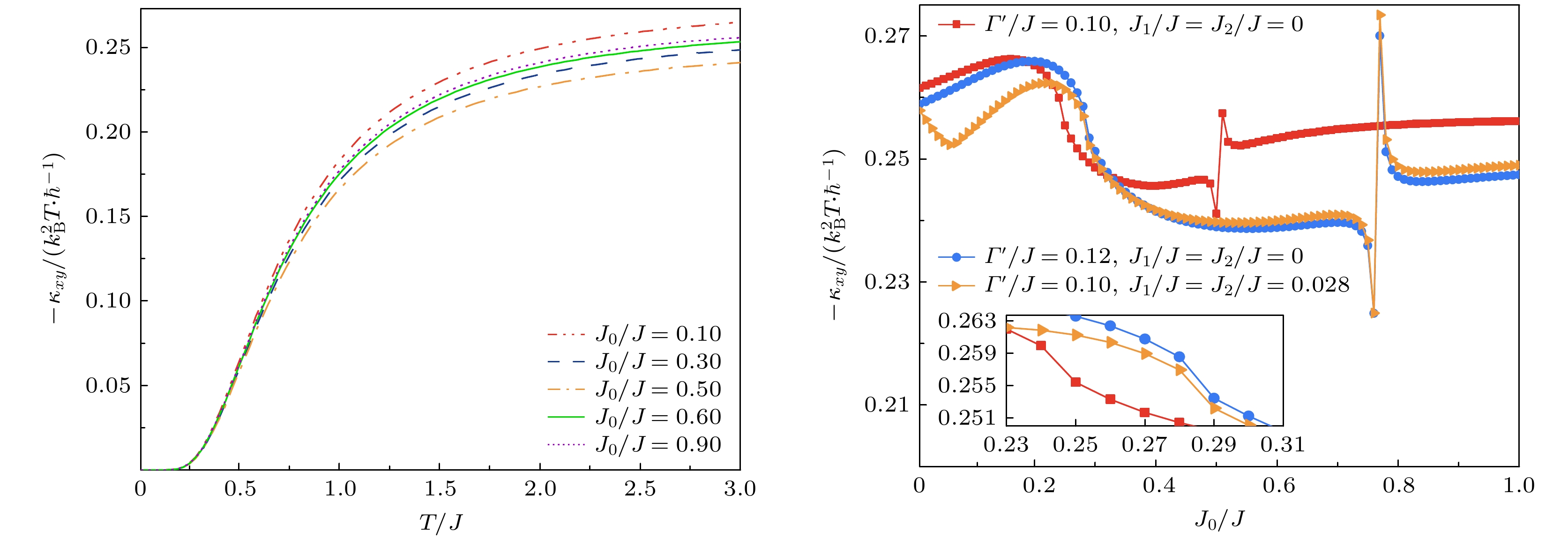
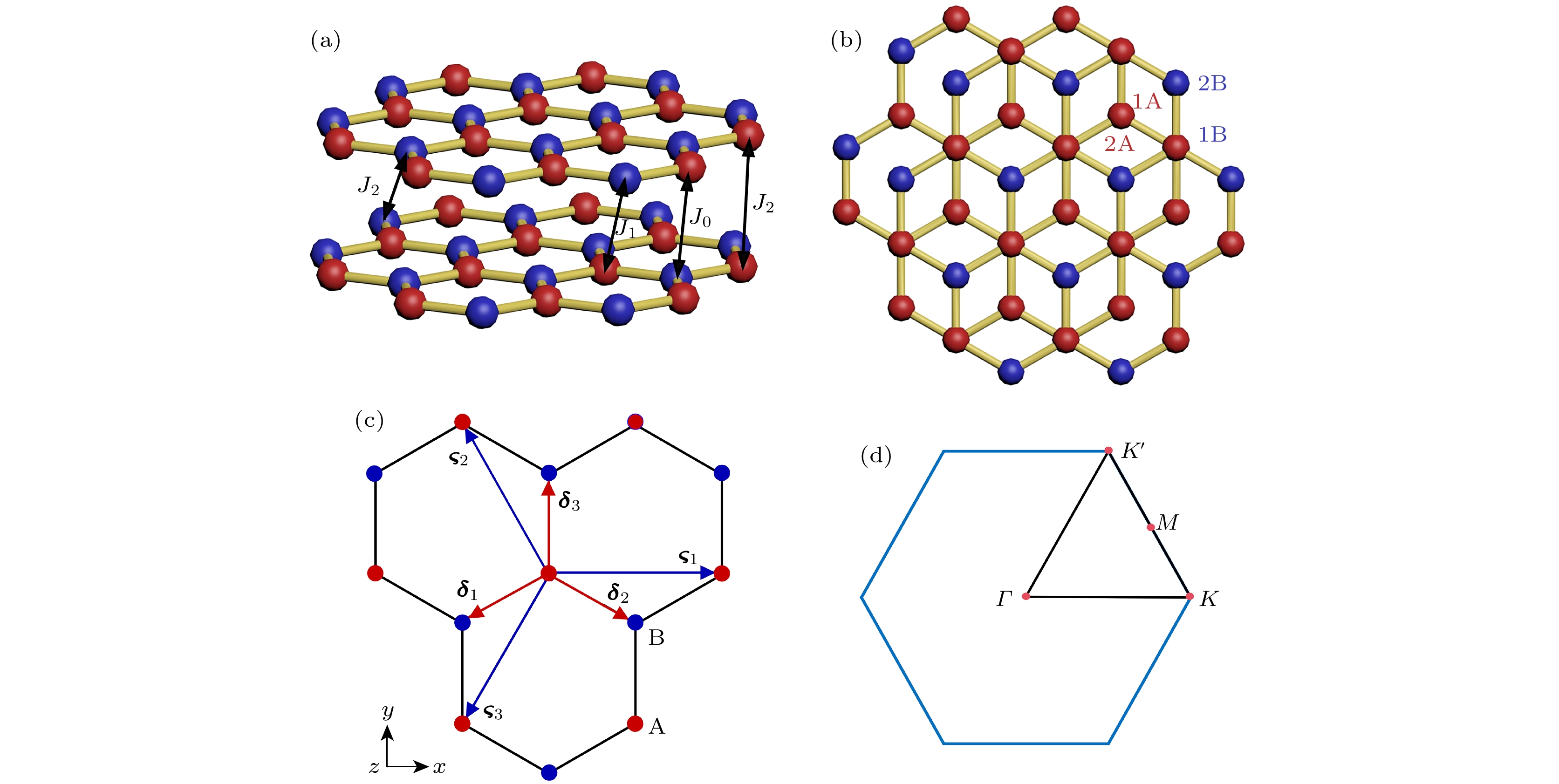
 下载:
下载:
